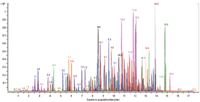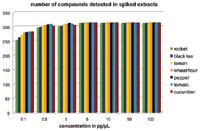Simultaneous Analysis of Hundreds of Pesticides in Food Samples using the Agilent 6400 Series Triple Quadrupole LC/MS
More than 1000 pesticides are currently used worldwide in the treatment of soil and crops. Many countries have established allowable levels of those pesticides in food to protect consumers. While these maximum residue levels (MRLs) vary, the default tolerance is 10 parts per billion (ppb).
The Challenge
More than 1000 pesticides are currently used worldwide in the treatment of soil and crops. Many countries have established allowable levels of those pesticides in food to protect consumers. While these maximum residue levels (MRLs) vary, the default tolerance is 10 parts per billion (ppb). However, the MRL for pesticides in baby food can be as low as 4 ppb.
These pesticides have to be monitored as part of the quality control of food, especially fruits and vegetables, challenging food producers to detect and quantify hundreds of compounds present at minute levels. Since analyzing all of these compounds separately is not feasible, multi-compound methods are required. However, the ability to monitor hundreds of pesticides at once is a challenging problem for chromatography and mass spectrometry.
Meeting the Challenge
A method that can simultaneously detect and quantify hundreds of pesticides requires a liquid chromatography (LC) system that can generate very sharp peaks and rapid separations. It also requires a triple quadrupole mass spectrometer (MS) that can provide excellent selectivity and sensitivity in very complex matrices, along with short dwell times that allow the analysis of peaks only seconds in width.
Rapid and effective development of multi-pesticide methods also requires a reliable and fast sample extraction method, as well as access to a database that contains method parameters for hundreds of compounds.
The Agilent Solution
Development of methods that can screen and quantify hundreds of pesticides can be a daunting task. Agilent provides an effective solution that addresses all of the key requirements for successful method development. The Pesticides Dynamic MRM Database Application Kit includes a database with conditions, transitions and retention times for more than 750 compounds that can be used to generate custom methods. In addition, a pre-configured method for 300 pesticides is included with the kit.
We recommend Bond Elut QuECheRS extraction and dispersive kits for optimal sample prep. A ZORBAX Eclipse Plus UHPLC column provides excellent resolution on short columns for high sensitivity and rapid separations. The 1200 series LC systems utilize the UHPLC columns to provide very fast separations (<20 minutes) and very sharp peaks for the 300 pesticide method that maximize the number of components that can be identified and quantified (Figure 1).

Figure 1. Extracted Ion Chromatogram (EIC) of a 300-compound pesticide mixture using the Agilent 1290 Infinity UHPLC. The retention time is shown above each peak.
The Agilent 6400 series Triple Quadrupole LC/MS systems are also used with the kit to provide fast, multi-analyte quantification. They utilize Dynamic MRM, which monitors analytes only when they are eluting from the LC, to shorten cycle times and maximize the number of compounds detected in a chromatogram without dividing it into segments. The Jet Stream and Ion Funnel technologies also available with the 6400 series provide the sensitivity to detect as low as sub-ppb levels of pesticides in a wide range of fruit and vegetable matrices. (Figure 2).

Figure 2. The number of compounds detected in extracts of a variety of fruits and vegetables spiked with the 300 pesticide mix at concentrations from 0.1 to 100 ppb, using the 1290 Infinity UHPLC and the 6490 Triple Quadrupole LC/MS.
For more details on the Pesticides Dynamic MRM Database Application Kit, 1200 Infinity Series LC systems, and 6400 Series Triple Quadrupole LC/MS systems for pesticide applications, visit the Agilent Technologies web site at: www.agilent.com.
Analytical Challenges in Measuring Migration from Food Contact Materials
November 2nd 2015Food contact materials contain low molecular weight additives and processing aids which can migrate into foods leading to trace levels of contamination. Food safety is ensured through regulations, comprising compositional controls and migration limits, which present a significant analytical challenge to the food industry to ensure compliance and demonstrate due diligence. Of the various analytical approaches, LC-MS/MS has proved to be an essential tool in monitoring migration of target compounds into foods, and more sophisticated approaches such as LC-high resolution MS (Orbitrap) are being increasingly used for untargeted analysis to monitor non-intentionally added substances. This podcast will provide an overview to this area, illustrated with various applications showing current approaches being employed.
Extracting Estrogenic Hormones Using Rotating Disk and Modified Clays
April 14th 2025University of Caldas and University of Chile researchers extracted estrogenic hormones from wastewater samples using rotating disk sorption extraction. After extraction, the concentrated analytes were measured using liquid chromatography coupled with photodiode array detection (HPLC-PDA).

.png&w=3840&q=75)

.png&w=3840&q=75)



.png&w=3840&q=75)



.png&w=3840&q=75)



